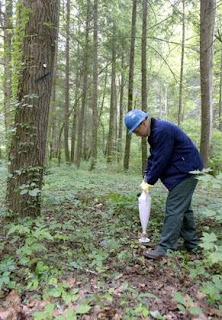 Hemlock trees across the eastern U.S. have been under attack by the microscopic wooly adelgid insect for several years. The bug came to America from Asia and can drain the life from hundred-year-old hemlocks within five to 10 years. Some are trying to save the trees with specialized pesticide treatments, by introducing predator beetles to kill the parasitic adelgid, or a combination of both. Foresters in the Cherokee and Chattahoochee-Oconee National Forests are fighting to save the hemlocks there, reports Pam Sohn of the Chattanooga Times Free Press. (TFP photo by Jake Daniels)
Hemlock trees across the eastern U.S. have been under attack by the microscopic wooly adelgid insect for several years. The bug came to America from Asia and can drain the life from hundred-year-old hemlocks within five to 10 years. Some are trying to save the trees with specialized pesticide treatments, by introducing predator beetles to kill the parasitic adelgid, or a combination of both. Foresters in the Cherokee and Chattahoochee-Oconee National Forests are fighting to save the hemlocks there, reports Pam Sohn of the Chattanooga Times Free Press. (TFP photo by Jake Daniels)Foresters have spent about $100,000 in each forest this year treating "the handful of hemlocks that have been prioritized by their location or their level of infestation," Sohn reports. Cherokee forester Eric Taylor said the forests have lost a lot of trees, but they hope the stands on which they are focusing can survive "in the worst-case scenario." Their treatment combines predator beetles and pesticides, which are injected into the ground around the roots so the tree takes it up through the trunk. Foresters said the pesticide "is more of a Band-Aid" until the beetle population builds up naturally.
There are 91 treatment sites in the Cherokee National Forest, with each site containing between 12 and 150 hemlocks. In Chattahoochee National Forest, there are 144 treatment sites of about nine acres each, with most infestation in the Blue Ridge and Chatooga districts. Foresters are trying to not only save the hemlocks, but also the habitat they provide. "It’s more than just saving a tree,” Chattahoochee public affairs officer Mitch Cohen said. "It maintains a higher diversity of species in those areas, and that makes the ecosystem more stable in the long run." (Read more)
No comments:
Post a Comment